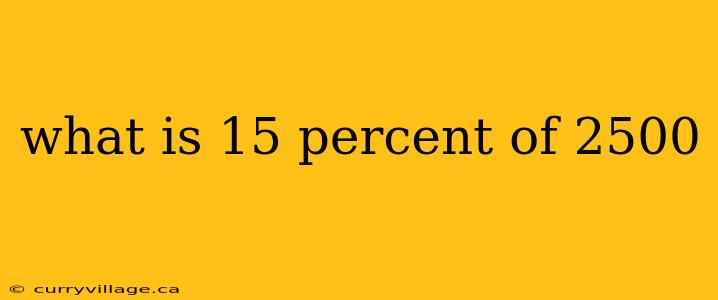Finding a percentage of a number is a common calculation in many areas of life, from calculating sales tax to determining discounts. This article will walk you through how to calculate 15 percent of 2500, explaining the process clearly and simply. We'll also explore different methods to solve this problem, catering to various levels of mathematical understanding.
Understanding Percentages
Before we dive into the calculation, let's quickly refresh our understanding of percentages. A percentage is a fraction expressed as a part of 100. For instance, 15% means 15 out of 100, or 15/100.
Method 1: Using Decimal Conversion
This is the most straightforward method. We convert the percentage to a decimal and then multiply it by the number.
-
Convert the percentage to a decimal: To do this, divide the percentage by 100. 15% / 100 = 0.15
-
Multiply the decimal by the number: 0.15 * 2500 = 375
Therefore, 15% of 2500 is .
Method 2: Using Fractions
This method uses the fractional representation of the percentage.
-
Express the percentage as a fraction: 15% can be written as 15/100.
-
Multiply the fraction by the number: (15/100) * 2500
-
Simplify the calculation: Notice that 2500 is divisible by 100 (2500/100 = 25). This simplifies the calculation to: 15 * 25 = 375
Again, we arrive at the answer: 15% of 2500 is .
Method 3: Using Proportions
This method uses the concept of ratios to solve for the unknown value.
We can set up a proportion:
15/100 = x/2500
Where 'x' represents the unknown value (15% of 2500). To solve for 'x', we cross-multiply:
100x = 15 * 2500
100x = 37500
x = 37500 / 100
x = 375
So, 15% of 2500 is .
Practical Applications
Understanding how to calculate percentages is essential in various real-world scenarios:
- Sales and discounts: Calculating discounts on items during sales.
- Taxes: Determining the amount of sales tax or income tax.
- Tips: Figuring out how much to tip at a restaurant.
- Finance: Calculating interest on loans or investments.
Conclusion
Calculating 15% of 2500, regardless of the method used, results in . We've demonstrated three different approaches—decimal conversion, fraction method, and proportion method—allowing you to choose the one that best suits your understanding and preference. Mastering percentage calculations empowers you to handle numerous everyday situations effectively.
